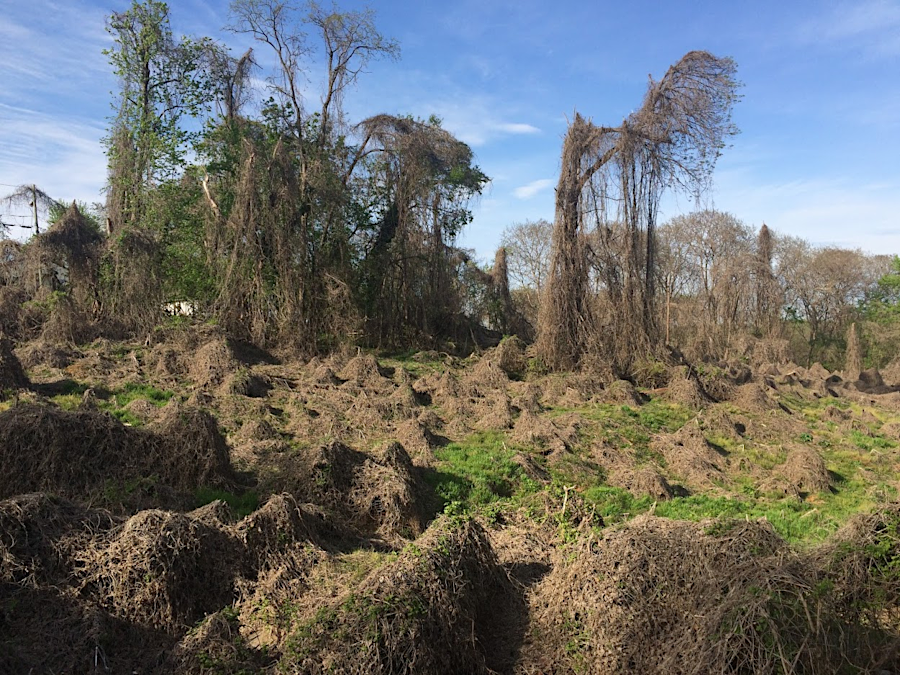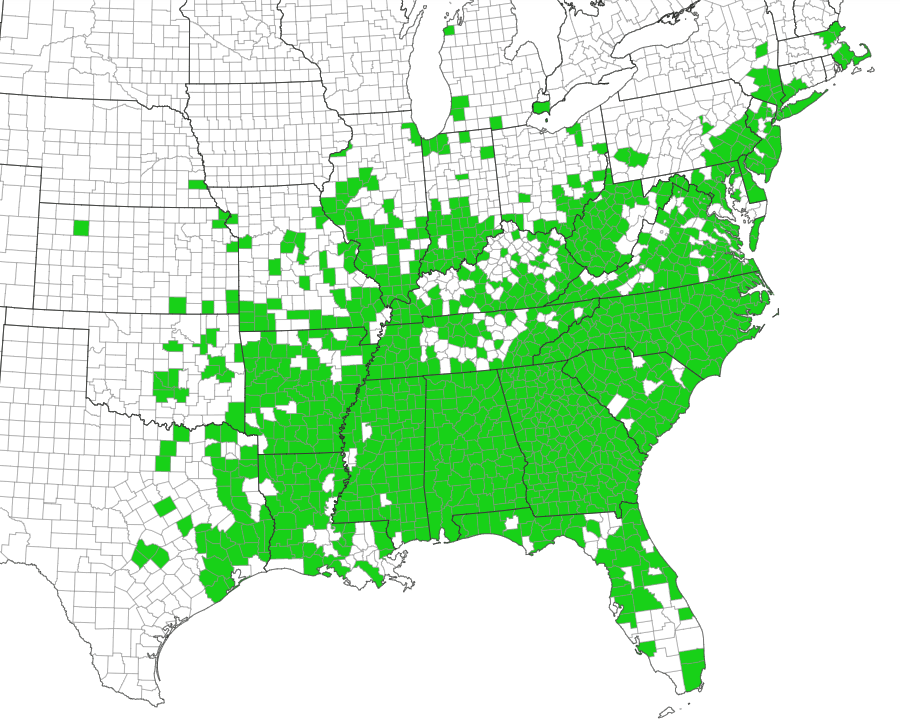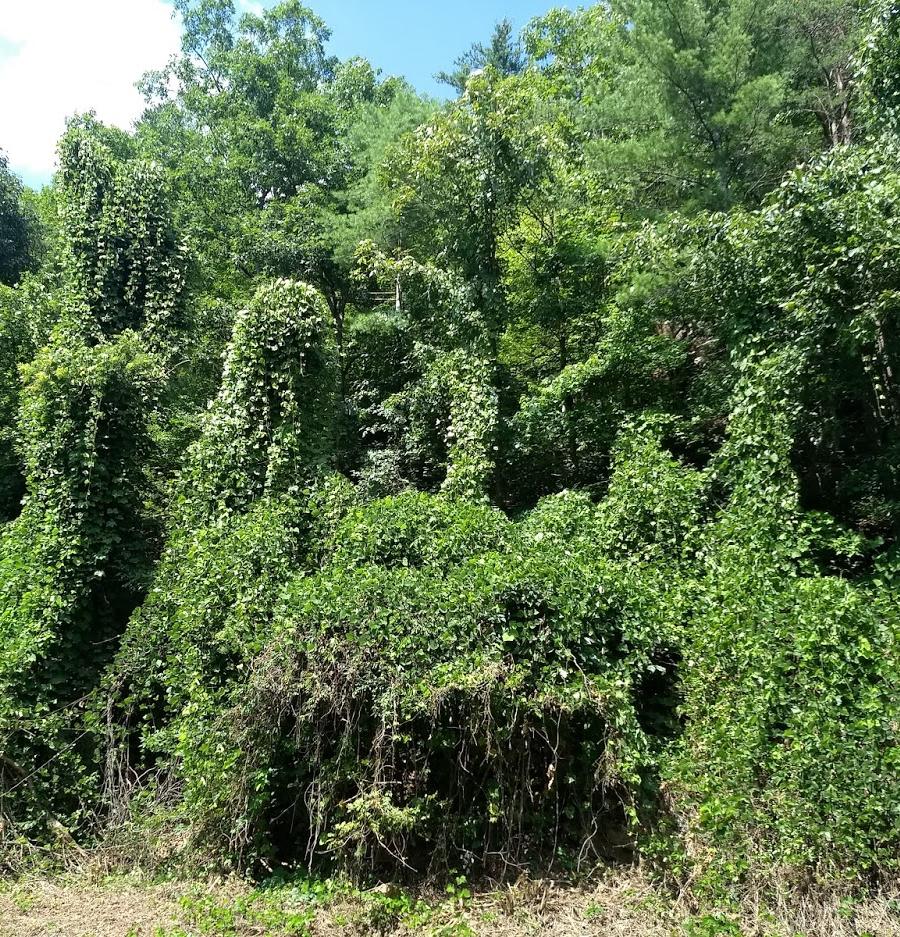
kudzu covering an abandoned lot in Lynchburg, before Spring growth

kudzu covering an abandoned lot in Lynchburg, before Spring growth
Kudzu (Pueraria lobata) is now a classic image of the South, since it is common on roadsides but rare in the colder areas north of Virginia.
Botanists displayed kudzu at the Philadelphia Centennial Exposition in 1876. The display at the Japanese pavilion during the New Orleans Cotton Exposition (1884-1886) helped popularize the plant with gardeners as an ornamental.
The US Department of Agriculture viewed its fast growth - as much as a foot/day, with vines reaching 100 feet in length - as a major benefit. During the Great Depression, the Soil Conservation Service paid farmers as much as $8/acre to plant kudzu on bare soils to reduce erosion. Radio personality Channing Cope formed the Kudzu Club of America in 1943 and popularized kudzu until he died in 1962.1

kudzu is primarily a plant of the southeastern states
Source: University of Georgia - EDDMapS, kudzu
Kudzu became popular with the highway departments because it grows very fast in poor soil. It was used to revegetate areas where the soil was disturbed by construction, under the theory that anything green that holds the soil against August thunderstorms is good. In a roadcut, bare red clay baking in the summer sun is a tough place to grow. Invasive species are typically able to get a competitive advantage in such disturbed sites, while most native species have evolved to thrive in the "normal" habitats.
One reason it does so well is because kudzu has partnered with bacteria to manufacture its own fertilizer, a trait common in other members of the pea family like clover and alfalfa. The ability to produce nitrates gives kudzu an advantage when competing with other species on thin soil at roadcuts.
However, kudzu is also a killer. It will grow overtop a forest, covering the canopy with a layer of vines that capture all the sunlight. That shades out the trees, and everything underneath dies. Then in the cold winters, the vines will freeze and the hillside will become a barren tangle of rotting trees and withered vines. The next spring, the vine-that-can-eat-a-forest will come back. The roots can weight up to 400 pounds, and do not freeze below the frost line in Virginia.2
James Dickey wrote in his poem "kudzu" that the vine was a green menace and repeated the legend:3
Kudzu is not a producer of nuts or fruits, or even leaves that are attractive to Virginia's wildlife. Insects and other animals in Virginia evolved to feed on native plants, and are not normally adapted to process the unusual proteins and carbohydrates in non-native species. Native wildlife suffers when a forest is converted into a kudzu-covered clump. Deer rarely browse the kudzu branches; wood thrushes do not nest in its branches.
The US Department of Agriculture's enthusiasm for kudzu was ephemeral. By 1953, it was no longer listed as an acceptable cover crop. By 1970, it was classified as an undesirable weed. Roadcuts were planted in fescues and lespedezas rather than kudzu.
Claims that kudzu covers millions of acres today are unsubstantiated. A 2011 Forest Service study estimated the vine covered less than 250,000 acres of Southern forests. In urban and suburban areas, it may cover an additional 500,000 acres.4
Small patches of kudzu can be killed by a homeowner cutting and pulling the vines, but over five million acres have been covered by kudzu now. Cattle will graze on the leaves, so it can be managed by livestock grazing as well as herbicides. Persistent management is required; damaged vines will go dormant but then resprout two years later.5

kudzu in July (Washington County)